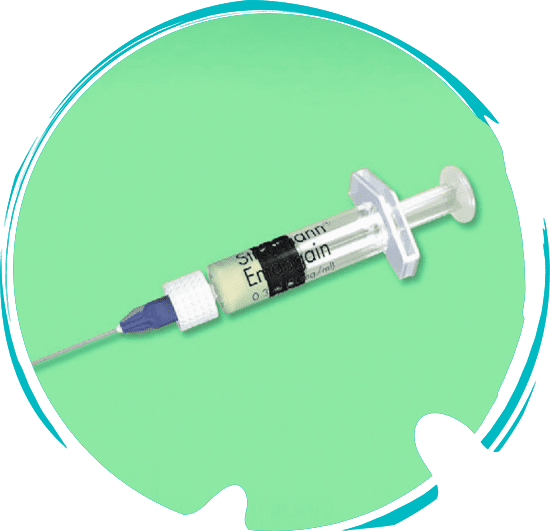
Gum Grafting for a Healthier Smile
If you have gum disease then you probably have some gum recession as well. Receding gums are what happens when your gum line starts to shrink toward the roots of your teeth.
Whether it affects one or more teeth, gum recession is a common indicator of gum disease with symptoms ranging from none to root sensitivity, inflamed and/or bleeding gums, cavities and uneven tooth exposure. Avoiding treatment could result in bone deterioration and tooth loss. Gum grafting fixes gum recession.
Gum grafting involves taking soft tissue – either from the patient’s own gums, roof of the mouth or from a tissue bank – to lengthen and repair the gum line. From a cosmetic standpoint, gum grafting can also improve the appearance of a naturally low gum line and soften the look of very large teeth.
Three Types of Gum Grafting



Connective-tissue gum grafting
Connective-tissue gum grafting
Connective-tissue gum grafting is the most common way to treat exposed roots around one or more teeth. Here’s how it works:
- The doctor cuts a small flap on the roof of your mouth, removes some tissue from underneath and secures it back down with a few stitches.
- The extracted tissue is stitched to the gum tissue surrounding the exposed root where they meld together to form a new, protective gum line around the tooth.
Free gingival gum grafting
Free gingival gum grafting
Free gingival gum grafting is the preferred method among periodontists for patients who have naturally thin gums. Here’s how it works:
- Very similar to connective- tissue gum grafting except tissue is removed directly from the mouth’s roof surface, not from beneath a flap.
- The extracted tissue is stitched to the gum tissue surrounding the exposed root where they meld together to form a new, protective gum line around the tooth.
Pedicle gum grafting
Pedicle gum grafting
Pedicle gum grafting is best for patients who still have good gum tissue around their teeth. Instead of taking tissue from the roof of the mouth, it’s pulled directly from the gums surrounding the teeth. Here’s how it works:
- The doctor cuts a small flap of tissue, called a pedicle, near the tooth.
- The flap is gently stretched either up or down (lower jaw/upper jaw) over the exposed root and stitched into place.

The Emdogain® Gel Advantage
Our doctor at Cook Periodontics uses Emdogain® Gel in gum grafting procedures and during periodontal surgery to help stabilize teeth and help improve the outcome of these procedures. Emdogain® Gel works by regenerating the tissue structures that anchor teeth in place. Since it was introduced in 1996, Emdogain® Gel has be safely used in millions of procedures worldwide. Studies continue to show that Emdogain® Gel can increase the predictability of surgical procedures and reduce post-surgical discomfort.
Emdogain® Gel is comprised of proteins that self-assemble to create a matrix. The dominant protein in the matrix, amelogenin, is responsible for tooth development. Because this protein is naturally found in the human body, no allergic or immunologic reactions will occur. Emdogain® Gel is applied topically during the surgery on exposed root surfaces. The protein then helps to rebuild bone and gum structures.

We can really improve someone's smile with Periolase and Chao Pinhole Technique


- Connective Tissue Graft
Recovering from Gum Grafting
Your gum grafting procedure is over and it’s time to go home! Just be sure to have someone else drive if you took a sedative during the procedure. Our doctor at Cook Periodontics may suggest anti-inflammatory medicine that you can buy at the drug store or prescribe pain medication. Many patients are able to return to work within 48 hours or less. During the week, it’s also important to practice good self-care so your gums heal properly.
Here’s what you should do:
- Follow the post-operative care instructions that the doctor gives you.
- Do not floss or brush the treated area until the gums are completely healed.
- Use the special mouthwash that your periodontist gives you – it helps control plaque.
- Eat only soft foods – eggs, pasta, gelatin, yogurt and other similar foods.
We are accepting new patients in both our Wilmington and Leland offices!
Dr. Deana Cook, located in Wilmington and Leland, NC, is an experienced periodontist who serves patients from Castle Hayne, Porters Neck, Odgen, Leland, Wrightsville Beach, Carolina Beach, Southport, and Hampstead. Dr. Cook, along with our entire team, is looking forward to welcoming you to our office and encourage you to schedule your appointment today!
Wilmington Office
7028 Wrightsville Avenue
Wilmington, NC 28403
Phone Number: (910) 256-8486
Monday: CLOSED
Tuesday: 8:00am – 3:00pm
Wednesday: 8:00am – 3:00pm
Thursday: CLOSED
Leland Office
1217 Magnolia Village Way
Leland, NC 28451
Current Patients: (910) 256-8486
Monday: 8:00am – 3:00pm
Tuesday: CLOSED
Wednesday: CLOSED
Thursday: 8:00am – 3:00pm


